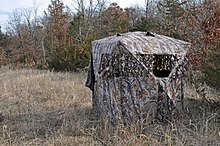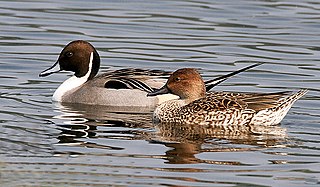
The pintail or northern pintail is a duck species with wide geographic distribution that breeds in the northern areas of Europe and across the Palearctic and North America. It is migratory and winters south of its breeding range to the equator. Unusually for a bird with such a large range, it has no geographical subspecies if the possibly conspecific duck Eaton's pintail is considered to be a separate species.

A retriever is a type of gun dog that retrieves game for a hunter. Generally gun dogs are divided into three major classifications: retrievers, flushing spaniels, and pointing breeds. Retrievers were bred primarily to retrieve birds or other prey and return them to the hunter without damage; retrievers are distinguished in that nonslip retrieval is their primary function. As a result, retriever breeds are bred for soft mouths and a great willingness to please, learn, and obey. A soft mouth refers to the willingness of the dog to carry game in its mouth without biting into it. "Hard mouth" is a serious fault in a hunting dog and is very difficult to correct. A hard-mouthed dog renders game unpresentable or at worst inedible.
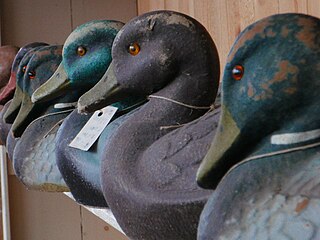
A decoy is usually a person, device, or event which resembles what an individual or a group might be looking for, but it is only meant to lure them. Decoys have been used for centuries most notably in game hunting, but also in wartime and in the committing or resolving of crimes.

The Federal Duck Stamp, formally known as the Migratory Bird Hunting and Conservation Stamp, is an adhesive stamp issued by the United States federal government that must be purchased prior to hunting for migratory waterfowl such as ducks and geese. It is also used to gain entrance to National Wildlife Refuges that normally charge for admission. It is widely seen as a collectable and a means to raise funds for wetland conservation, with 98% of the proceeds of each sale going to the Migratory Bird Conservation Fund.

Gun dogs or bird dogs are types of hunting dogs developed to assist hunters in finding and retrieving game, typically various fowls that are shot down on the wing. The term hunting dog is broad and includes all breeds and skills of hunting canines, but "gun dogs" refers to canines that are trained to work alongside a loud firearm while hunting or retrieving game. Gun dogs are divided into three main categories: pointers and retrievers, setters and spaniels, and water dogs.

The falcated duck or falcated teal is a gadwall-sized dabbling duck from the east Palearctic.
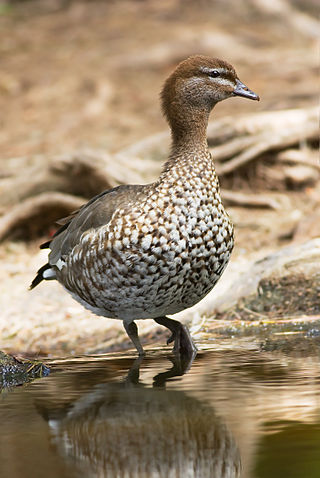
The Australian wood duck, maned duck or maned goose is a dabbling duck found throughout much of Australia. It is the only living species in the genus Chenonetta. Traditionally placed in the subfamily Anatinae, it might belong to the subfamily Tadorninae (shelducks); the ringed teal may be its closest living relative.

Waterfowl hunting is the practice of hunting aquatic birds such as ducks, geese and other waterfowls or shorebirds for sport and meat. Waterfowl are hunted in crop fields where they feed, or in areas with bodies of water such as rivers, lakes, ponds, wetlands, sloughs, or coasts. There are around 3 million waterfowl hunters in the United States alone.
Upland hunting is an American term for a form of bird hunting (fowling) in which the hunter pursues upland birds including quail, pheasant, grouse, woodcock, prairie chicken, chukar, grey partridge, and other landfowls. Unlike aquatic and semiaquatic bird species, upland birds are terrestrial and tend to be found strictly on the dry lands above the high mark of waterbodies, often hidden in heavy groundcover, so hunters generally employ the use of gun dogs to locate, expose and retrieve game. The average group consists of 2-4 hunters with 1-2 dogs.
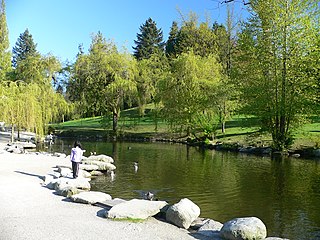
A duck pond or duckpond is a pond for ducks and other waterfowl. Duck ponds provide habitats for waterfowl and other birds, who use the water to bathe in and drink.

Big-game hunting is the hunting of large game animals for trophies, taxidermy, meat, and commercially valuable animal by-products. The term is often associated with the hunting of Africa's "Big Five" games, and Indian rhinoceros and Bengal tigers on the Indian subcontinent.

In the United Kingdom, the term hunting generally refers to hunting with hounds, e.g. normally fox hunting, stag (deer) hunting, beagling, or minkhunting, whereas shooting is the shooting of game birds. What is called deer hunting elsewhere is deer stalking. According to the British Association for Shooting and Conservation (BASC) over a million people a year participate in shooting, including stalking, shooting, hunting, clay shooting and target shooting. Firearm ownership is regulated by licensing.

A sneakbox is a small boat that can be sailed, rowed, poled or sculled. It is predominantly associated with the Barnegat Bay in New Jersey, just as the canoe-like Delaware Ducker is associated with the New Jersey marshes along the Delaware River near Philadelphia.
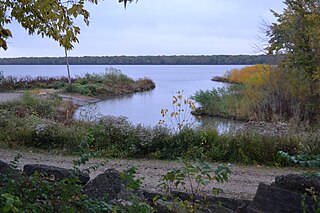
Marshall State Fish and Wildlife Area is an Illinois state park on 6,000 acres (2,400 ha) in Marshall County, Illinois, United States.

Sanganois State Fish and Wildlife Area is an Illinois state park on 10,360 acres (4,190 ha) in Cass, Schuyler, and Mason County, Illinois, United States.
A hunting season is the designated time in which certain game animals can be killed in certain designated areas. In the United States, each state determines and sets its own specific dates to hunt the certain game animal, such as California, in which they designate certain zones, in which each have their own separate dates in order to legally hunt.

A duck call may be either the sound-imitation process used in waterfowl hunting, by which a hunter lures waterfowl, or the actual tool which the person uses to do so. Early duck call tools were basic woodwind instruments, while later innovations are constructed of rubber and plastic, and allow the hunter to adjust the volume and tone of the calls with reeds. Today's duck calls usually fall into three main categories: single, double, or triple reed call with many variations, although the triple reed is rare. The goal of a duck call is to sound like a realistic live duck, in attempts to decoy, or fool a duck into believing the decoys that are seen by a duck, and the sound that is heard appears lifelike.
A duck decoy is a man-made object resembling a duck. Duck decoys are typically used in waterfowl hunting to attract real ducks, but they are also used as collectible art pieces. Duck decoys were historically carved from wood, often Atlantic white cedar wood on the east coast of the United States, or cork. Modern ones may also be made of canvas and plastic. They are often painted to resemble various kinds of waterfowl.

Layout boat hunting is a sub specialty of traditional waterfowl hunting which is done in a low-profile un-motorized boat with a unique design that allows the hunter to maintain a close position to the water in order to conceal them in open water areas that are frequented by diver and ocean ducks. This is a sport with a long history going back to market hunters and boat-mounted punt guns. The main focus of the layout boat is to put the hunter very close to the decoys, or even among them, for additional concealment. This makes for dramatic hunting scenarios where a decoying bird comes extremely close to the hunter and boat.
Australia has a population of about 26 million while the Commonwealth Government estimating there are 640,000 recreational hunters in the country. There are around 6 million legally owned guns in Australia, ranging from airguns to single-shot, bolt-action, pump-action, lever-action or semi-automatic firearms.
